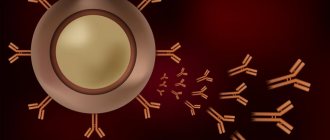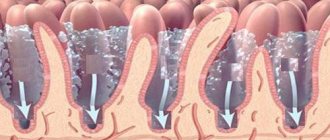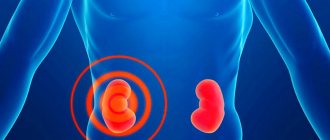Weight loss in a cancer patient is not the first sign of cancer. This symptom appears at a late stage, when no one has any doubt about the progression of the malignant tumor.
When they begin to look for a tumor in a significantly thinner person who has somehow avoided the attention of doctors, it is reckless to hope for stage I–II or even stage III of the tumor process—most likely, metastases will be found.
Even with stomach and pancreatic cancer, in which eight out of ten patients experience significant weight loss, the presence of an operable tumor can be considered a miracle. Of course, there are options when, against the background of as yet undiscovered cancer, a person begins to quickly lose weight. But this symptom is noted among others that are much more actively disturbing to the patient. For example, fever, severe pain in muscles and joints, as happens with some forms of lung cancer. Weight loss in this case is not associated with the tumor, it is secondary - the person is so bad that he has no time to eat.
When a cancer patient loses weight
During cancer treatment, patients often have to lose weight. During cancer surgery, there is no appetite before surgery due to stress. After surgery, you cannot eat as you want. As a rule, by the end of the first week an appetite appears, and after 3-4 weeks the weight returns to normal. After surgery on the gastrointestinal tract, the rehabilitation process is quite long, but weight loss is compensated over time, although not 100%.
During chemotherapy courses, there is no time to eat at all: nausea, vomiting, damage to the mucous membranes of the oral cavity and gastrointestinal tract. And also drug-induced anorexia - suppression of appetite due to taking certain medications. Radiation therapy can also initiate nausea - the esophageal mucosa is damaged by irradiation of the mediastinal organs, lung or mammary gland with areas of lymphatic drainage. When the organs of the genitourinary system are irradiated, the large intestine and rectum “burn”, which itself reduces appetite. Plus protective dietary restriction to reduce the frequency of bowel movements.
In all these situations, weight does not decrease by more than 5% of the original, and after treatment, the body mass index tends to increase. The main thing that distinguishes weight loss from cancer cachexia is the possibility of trouble-free weight gain after completion of the treatment process.
Prognosis and prevention
The prognosis depends on the underlying disease causing cachexia. However, sudden weight loss is sometimes an important prognostic sign. For example, in the case of oncology, cachexia indicates the progression of cancer.
For eating disorders (anorexia, bulimia), the prognosis is more favorable. However, it is important to start treatment as early as possible, before complications arise.
There are no specific preventive measures for cachexia. It cannot be avoided when it comes to cancer or other serious pathology. Dramatic weight loss can be prevented by intentional fasting or the wrong weight loss diet. Consultations with specialized specialists will help with this: nutritionist, psychotherapist, psychiatrist.
Anorexia-cachexia syndrome
Until the beginning of the 21st century, it was simply called cachexia, which means bad condition in Greek. Cachexia is not just weight loss, as is commonly believed. This is a disease state characterized by loss of muscle mass, while loss of fatty tissue is optional. Muscle tissue is lost due to a combination of eating disorders - anorexia and metabolic disorders.
Anorexia-cachexia syndrome in cancer patients (ACCS) is composed of four symptoms:
- reduction in skeletal muscle mass;
- anorexia – pathological lack of appetite, even to the point of disgust;
- rapid saturation with small amounts of food;
- fatigue.
This syndrome develops in the last stage of stomach and pancreatic cancer, in more than half of patients with lung, colon and prostate cancer, and in every third or fourth patient with breast cancer. In the terminal stage of the cancer process, when the progression of the tumor can no longer be stopped, anorexia-cachexia syndrome can develop with any malignant tumor.
Anorexia-cachexia syndrome is triggered by a malignant tumor; through its vital activity it captures more substances and requires more energy than it supplies with nutrients. In addition to this, the tumor significantly reduces appetite and disrupts the digestion process itself. In 25% of cancer patients, SACOB is the cause of death.
Classification of cachectic conditions
Cachexia on sick leave is most often indicated by code R64 according to the ICD-10 classification, which refers to the section “General symptoms and signs”, since cachexia does not manifest itself as an independent disease, but is a consequence of other pathological processes.
There are several types of cachexia, depending on the causes of its origin. Pituitary and cerebral cachexia are a consequence of disorders of the brain (pituitary gland and hypothalamus). Moreover, the disorders themselves may have different etiologies. Nutritional cachexia is the result of prolonged malnutrition or starvation. Malignant cachexia develops in cancer patients. Cardiac cachexia is the result of chronic heart failure (CHF), which occurs in severe form. In addition, senile cachexia is classified as a separate category.
There is another classification of cachexia, depending on the direction of the factor that provoked it.
- Cachexia of exogenous origin is exhaustion provoked by external factors: environmental influences, lack of nutrition, fasting (including for religious reasons or for the purpose of losing weight).
- Cachexia of endogenous origin is exhaustion provoked by internal causes and malfunctions of the body. This includes cachexia, which is a consequence of chronic diseases, metabolic disorders, pathologies of the endocrine system, senile involution, and injuries.
In modern medicine, it is customary to distinguish three forms of this disease.
- In the hypothalamic form of cachexia, the synthesis of peptides in the plasma stops or worsens. As a result, metabolic processes are suppressed, synthesis is disrupted and transport of fats is suppressed, and protein metabolism is disrupted.
- In the cachectic form of cachexia, the production of cachectin (TNF-a, TNF - a non-glycosylated protein that has a cytotoxic effect on tumor cells) increases significantly. This disorder is usually a consequence of tuberculosis or cancer. As a result, the patient's appetite decreases, frequent emotional breakdowns are observed, and the synthesis of neuropeptides (proteins that regulate physiological functions) is disrupted.
- In the anorexic form of the disease, absorption processes in the small intestine are disrupted, tumors grow, the function of the adrenal cortex decreases, and blood sugar levels drop.
How the body spends itself on energy
In a healthy body, a balance is maintained between calories received from food and energy expenditure; weight gain is more natural than weight loss. In any case, gaining weight is much easier than losing weight—considerable efforts are made to achieve this. With all the complexity of the processes occurring in the body, the entire system is tritely configured to create reserves in case of unexpected starvation. Nature has taught the body to store more substances than it spends.
When the supply of nutrients is limited due to diet or illness, energy expenditure to support life processes is maintained. And the first thing that begins is the utilization of reserves of subcutaneous fat, from which everything necessary is drawn. When subcutaneous fat runs out, it is the turn of the internal abdominal fat, then energy is drawn from the organs, where there are also fat cells. And only after the breakdown of fats into energy needs, muscle tissue proteins are used. And when “eating” muscles, the order is also included: skeletal muscles, then proteins from organs. And the more important the organ, the later it is “disassembled” into amino acids, which become a source of energy.
Diagnostics
Determining the presence of exhaustion in a patient is not difficult, but to determine the cause of cachexia and the degree of its severity, a number of diagnostic measures are carried out. After an initial examination, including a physical examination and questioning of the patient, the doctor may prescribe one or more of the following types of diagnostic procedures:
- Ultrasound examination (ultrasound) of the abdominal organs;
- donating blood for laboratory tests (general, biochemical, hormonal);
- magnetic resonance imaging (MRI) of the brain;
- general urine analysis;
- bacteriological culture (bacteria culture) of biomaterial to identify signs of sepsis;
- chest x-ray;
- endoscopic examinations (colonoscopy, hysteroscopy, gastroscopy, esophagogastroduodenoscopy, etc.)
After receiving and deciphering the test results, the specialist determines treatment tactics. Often, doctors of several specializations take part in drawing up a treatment program, which is due to the multifactorial etiopathogenesis of the disease. Advice on treatment options can be provided by specialists qualified in the following areas of medicine:
- neurology;
- psychiatry;
- endocrinology;
- oncology;
- surgery;
- gastroenterology.
Degrees of cachexia
Cachexia not only leads to loss of strength, it changes the response to anticancer treatment and impairs tolerability, which has a fatal effect on life expectancy.
With a loss of no more than 5% of body weight over six months, accompanied by a pathological aversion to food and signs of inflammation, precachexia is assumed. A systemic inflammatory reaction can be considered when the temperature is above 38 °C or below 36 °C, tachycardia from 90 beats, rapid breathing, white blood cells above 12 thousand or below 4 thousand. Only at the stage of precachexia can treatment stop the loss of muscle mass, which will change the immediate fate of the patient.
If there is a loss of more than 5% of weight with all the indicated signs, they speak of cachexia itself. The same condition occurs in a patient with initially low weight with a loss of only 2% of body weight. Further decline is not just a decrease, but a form of exhaustion with the inability to get out of bed or, due to weakness, spend more than half a day in it, unresponsive use of antitumor therapy is already refractory cachexia.
Symptoms
The manifestations of cachexia vary depending on the type of disease that provokes it, but a common and constant symptom is a rapid decrease in body weight (up to 50% of the original). Other common symptoms present in the medical history are:
- asthenia (general weakness, impotence, irritability);
- subdepressive state (deterioration of mood, apathy, demotivated behavior);
- low blood pressure;
- muscle hypotonia (decreased muscle tone);
- protein-free edema (due to impaired lymph flow, fluid is removed from the tissues and accumulates in the serous cavities);
- decreased glomerular filtration rate in the kidneys (the passage of fluid through the renal vessels);
- keratinization and drying of the skin (the skin becomes flabby and acquires an unnatural color, wrinkles appear);
- crumbling, tooth loss;
- frequent dizziness;
- a feeling of coldness in the extremities without fever (occurs due to a reduction in the volume of circulating blood);
- the appearance of ulcers in the mouth (stomatitis);
- increased brittleness of nails and hair loss;
- severe and prolonged constipation;
- decreased potency in men, amenorrhea (absence of menstruation for 3 or more months) in women;
- disturbance of the intestinal microflora, manifested in the form of deterioration of peristalsis (dysbacteriosis).
In most cases, all or most of the listed symptoms are present, less often the clinical picture is supplemented by atypical phenomena. Severe forms of the disease that provokes cachexia or a period of its exacerbation may be accompanied by the addition of the following conditions to the main symptoms:
- amentia (temporary clouding of consciousness, expressed in incoherent speech and movements);
- severe or rudimentary forms of delirium (a mental disorder accompanied by hallucinations and delusions);
- pseudoparalysis (unreasonably elevated mood, carelessness, committing ridiculous acts).
Treatment of cachexia
Even when the process of exhaustion has gone very far, and it is no longer possible to prevent the ongoing melting of skeletal muscles, it is necessary not only to maintain life in a person - it is necessary to improve his condition. It is imperative to reduce the manifestations of symptoms that affect the decrease in nutrient intake: reduce nausea, treat damage to the mucous membranes. Try to increase your appetite and relieve pain, because when you are in pain you don’t think about food. And, of course, establish nutrition with special mixtures and protein solutions.
There are more treatment options than patients and even therapists realize. It is impossible to cure cachexia, but giving a person the opportunity to live is possible and necessary. And this is what Euroonco doctors do.
Book a consultation 24 hours a day
+7+7+78
Complications
In the absence of timely measures taken to normalize metabolic processes, exhaustion reaches an extreme degree and can lead to negative consequences. The most dangerous possible complications of progressive weight loss include:
- dehydration (dehydration) of the body;
- internal bleeding (with peptic ulcer of the stomach or intestines);
- irreversible loss of consciousness;
- mental disorders (apathetic stupor, chronic asthenia);
- worsening of the primary disease;
- sepsis (blood poisoning);
- hypo- and vitamin deficiencies;
- development of renal and heart failure;
- coma.
What can be done
In stage 4 malignant tumors, it is extremely difficult to prevent an unfavorable outcome of the disease. When there is cancer cachexia, the oncologist will do everything possible to prolong the patient’s life - it is not the victory that is important, but the quality of life in the last leg of the journey. The main methods of therapy include:
- Elimination of metabolic disorders with correction of body weight and restoration of normal eating behavior;
- Removal of the tumor as the main source of parasitism;
- Antitumor treatment to suppress distant metastases.
At the first stage of therapy, it is necessary to help the exhausted body of a sick person, creating conditions for restoration of strength and elimination of tumor poisoning. Having smoothed out cachectic manifestations, you can operate (without removing the tumor, it is impossible to even try to defeat the disease). A long postoperative recovery period requires careful and constant medical supervision - cancer cachexia rapidly and irreversibly destroys the body, so there is no need to expect a quick cure. If, against the background of stage 4, you managed to live more than 1 year without pain and with a normal quality of life, then this will be a huge success. Having looked into the abyss, you need to move away from the edge of the abyss and try to survive, even if it seems that this is impossible.
Neurotrophic form
The neurotrophic form includes various trophic disorders due to damage to the hypothalamus: trophic ulcers, focal or diffuse edema of different parts of the body (especially in combination with vegetative-vascular crises), brittle nails, osteoporosis, osteodystrophy, some types of alopecia /hair loss/. In its pure form, the neurotrophic form is rare, and trophic disorders are included in the structure of other forms of hypothalamic syndrome, more often in the neuroendocrine-metabolic form.
Sympathoadrenal crisis
Sympathoadrenal crisis in hypothalamic syndrome is manifested by severe headache, pain in the heart, palpitations, a feeling of fear, palpitations, a feeling of fear, difficulty breathing, numbness of the extremities. During a crisis, the skin is pale, dry, blood pressure (BP) is elevated, there may be slight hyperthermia (37.0; 37.1; 37.2; 37.3; 37.4; 37.5; 37.6; 37.8 ; 37.9 degrees Celsius), dilated pupils, increased erythrocyte sedimentation rate (reaction) (ESR, ROE), hyperglycemia (increased blood glucose levels). The attack often ends with chills, frequent urination (pollakiuria) or a single copious discharge of urine (polyuria).
Video
Cachexia. Influence on the results of antitumor treatment (V.K. Lyadov)
Attention! The information presented in the article is for informational purposes only. The materials in the article do not encourage self-treatment. Only a qualified doctor can make a diagnosis and give treatment recommendations based on the individual characteristics of a particular patient.









